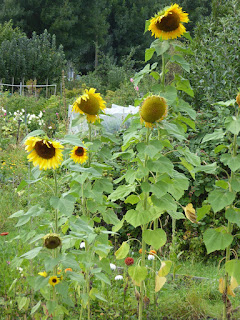The final leg of our rambles along the Lea Valley brought us gazebos, a historic school, a bed
mentioned by Shakespeare, a floral bear and even a buzzard.
The gazebos were a
surprise. They line the river, and were mostly built in the eighteenth and
nineteenth centuries by innkeepers whose establishments ran along the High Street,
and who sought to provide quiet areas for leisure and refreshment away from the
coaches and carts. (Ware was an important stop on the Old North Road, being less
than a day from London.) In the 1850s there were 25 of them. After World War II,
they fell into disrepair because of threatened demolition for a proposed service road between the High Street and
the river. Luckily the threat was eventually lifted and restoration began.
Behind
the High Street we found a yard with the figure of a Bluecoat pupil over it.
This led to a charming public garden in front of the 14thc manor house that served
as a Bluecoat charity school from 1685 to 1761.
An adjacent row of cottages
provided accommodation for 150 boys and the nursemaids who looked after them. Today the manor house is cared for by the
Hertfordshire Building Preservation Trust.
More reminders of Ware’s past were
all along the High Street – blue plaques marking the passageways that used to
lead to the stables of the coaching inns. One commemorates the White Hart, now
demolished. This was the home of the
Great Bed of Ware, built in 1580 by a Hertfordshire carpenter, Jonas Fossbrooke.
More than three metres wide and publicised as being able to sleep 12,
it was said to draw travellers to break their journey there, just to spend a night in
the bed. Its fame even led to a mention in Shakespeare’s Twelfth Night. Now a
prize exhibit at the Victoria and Albert Museum in London, in 2012 it returned
to Ware Museum for a year, thanks to a Heritage Lottery Fund grant.
Ware also
has an ancient priory, founded by the Franciscans in 1338. It became a private
residence with the Dissolution of the Monasteries under Henry VIII and is now a
wedding and conference venue.
In the surrounding gardens was an enormous floral
bear, part of the Ware in Bloom initiative.
The path took us back to the river, where mallards
foraged for food around huge gunnera plants. A few of the trees that line the banks were
just starting to show the first signs of autumn.
Houseboats, however, were
still ablaze with summer flowers.
The surrounding meadows were full of Canada and
Greylag geese.
One of our group identified a buzzard’s call (they sound like a
mewing cat) and finally spotted it hovering over some the trees.
When we
reached Hertford Lock we were intrigued by this metal plaque beside the towpath,
and its letters, RLT. Our guesses as to what they represented were right –
later investigation showed it was a boundary marker put up by the River Lee
Trust in 1866, probably to mark the realignment of the Lee Navigation.
As we approached
Hertford itself, allotments appeared and the waterway became crowded with boats.
We walked into Hertford, which we had visited early on in our exploration of
the valley (see http://greenjottings.blogspot.co.uk/search?q=hertford) and returned to the historic Salisbury Arms Hotel for a very welcome pub lunch.
Then it was back to Hertford East station, and the train home.













It was a very good read. I wish there were event halls for rent like this. It would have made the party livelier. I thoroughly enjoyed reading this post and I would love to forward it as well. Keep posting such amazing posts, I love reading it!
ReplyDelete